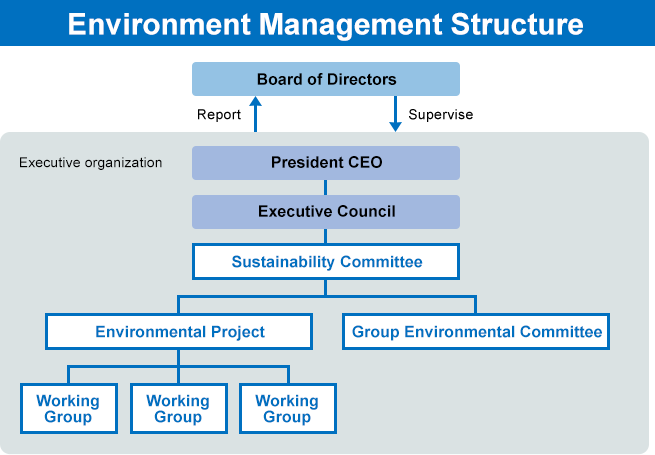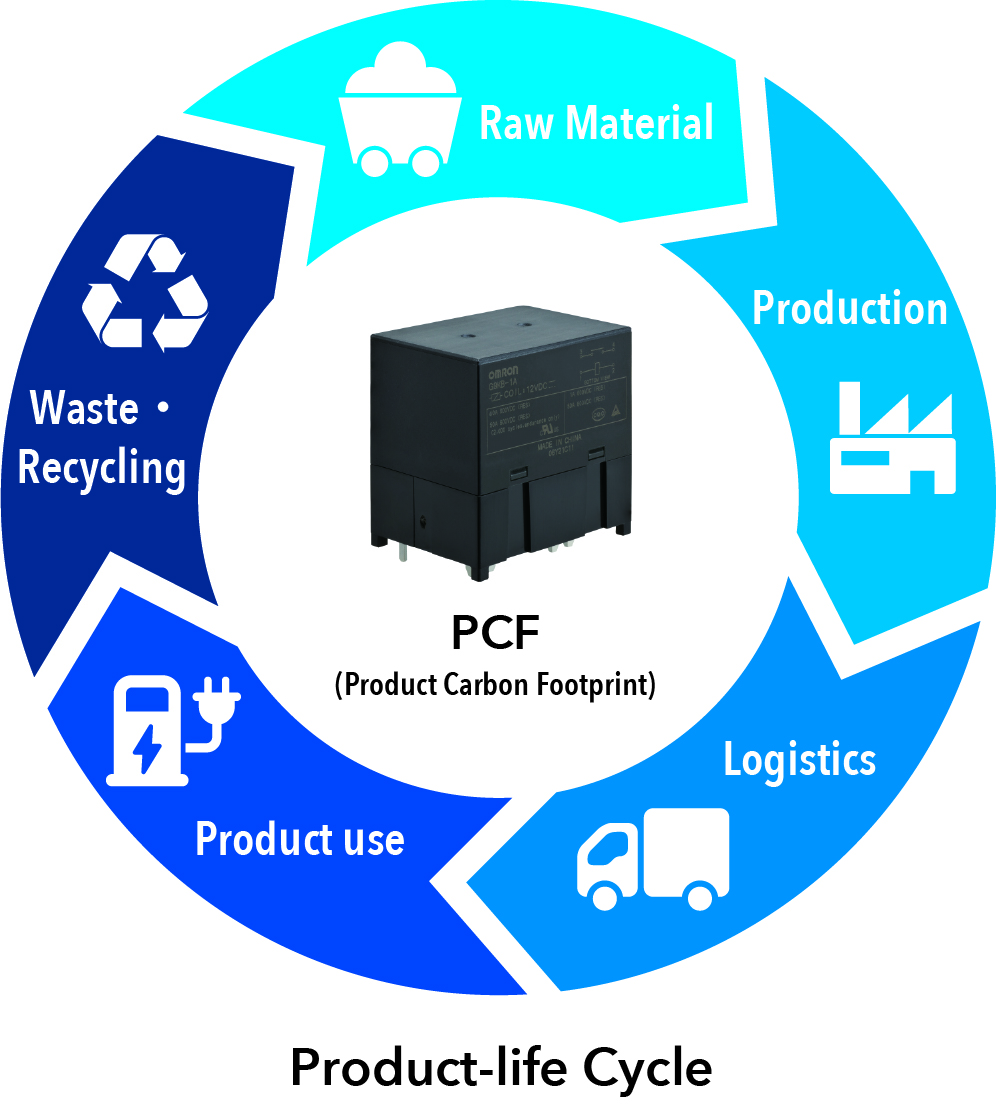Adhering to the OMRON Principles, the OMRON Group is striving to enhance its corporate value by addressing social issues and contributing to enrich the lives of people through its businesses.
As for the environmental aspects, the Group provides products and services that can contribute to protect the global environment, while also promoting environmentally conscious business activities.
At the Executive Council, chaired by the President, overall achievements linked to sustainability goals, including environmental goals are reported annually. In addition, we report, discuss and decide on the introduction and modification of common Group-wide environmental policies and systems, and report material matters to the Board of Directors. The Board of Directors, upon receiving the reports, monitors and supervises the progress of sustainability goals and policies.
Starting in fiscal 2021, in order to clarify management's responsibility for environmental initiatives, we have adopted GHG emissions reduction targets and third-party sustainability indicators (Dow Jones Sustainability Indices) as part of evaluation indicators for medium- to long-term performance-linked remuneration (stock remuneration) for internal directors and executive officers.
Besides, with the aim of further strengthening sustainability governance, including environmental initiatives, we appointed a director in charge of environmental management and a Sustainability Executive Officer in fiscal 2023, and established a "Sustainability Committee (which meets quarterly in principle)" chaired by the Sustainability Executive Officer to deliberate on group-wide environmental measures and responses to environmental laws and regulations.
Furthermore, for strengthening environmental management at business sites, we have established a Group Environmental Committee (meets quarterly in principle), consisting of the environmental management departments in HQs and the environmental departments at each business company. The committee discusses environmental goal setting and implementations plans for each business site, and reports on their performance. By sharing the environmental efforts and issues at each site and considering optimal measures, we aim to enhance the level of environmental management throughout the Group.
In order to accelerate group-wide environmental measures, including for products and services, we have launched an Environmental Project, consists of members in functional departments in HQ and each business company. Through the project, we identify environmental issues that have a large impact on the OMRON Group, consider measures, and measure the effectiveness of these measures, while promoting environmental management.
For individual themes such as LCA and PCF, we have made working groups with members own specialized knowledge and experience, and are working on specific measures.

We believe that an environmental management system (EMS) is the best way to engage in PDCA for environmental targets, improvement of environmental performances, prevent pollution, and ensure compliance with environmental laws and regulations. In this context, we pursue ISO 14001 certification.
The OMRON Group Rules stipulate that all OMRON Group production sites must acquire ISO 14001 certification. We aim to have all production sites added through M&A acquire certification within three years.
In fiscal 2023, all of our 24 production sites were covered for the certification, and all continued to be certified, with the percentage of certified production sites remaining at 100%.
We will continue to maintain ISO 14001 certification in the future.
| Center Classification | Details | Acquisition rate | ||
|---|---|---|---|---|
| Japan | Overseas | |||
| Production centers | 24 | 11 | 13 | 100% |
| Non-production centers | 32 | 30 | 2 | ’╝Ź |
| Total | 56 | 41 | 15 | ’╝Ź |
(As of Mar. 31, 2024)
Environmental Evaluation Framework evaluates products from a life cycle perspective and visualizes their environmental performance to create a sustainable economy. The goal of this framework is to advance our environmental initiatives and increase customer value.
Environmental Evaluation Framework

Our Environmental Evaluation Framework is based on the EU Taxonomy Environmental Objectives and establishes five key environmental aspects that must be addressed to achieve a sustainable economy. We evaluate each key environmental aspect through our product environmental assessment to confirm that all our products are Environmentally Conscious Products. We refer to products that demonstrate outstanding effects in specific environmental characteristics as Environmental Contribution Products, and define them as products that contribute to achieving a sustainable economy.
Five Key Environmental Aspects

The product environmental assessment evaluates*1 each key environmental aspect, designating products that meet the criteria as Environmentally Conscious Products. All products must pass this assessment before market launch, making all OMRON products Environmentally Conscious Products.

| Limit to use regulated chemical substances specified at OMRON |
| Energy-saving, such as power consumption and efficiency |
| Resource-saving |
| Reusability & recyclability |
To reduce environmental impact, we consider the followings at the product planning and design stage:
| OMRONŌĆÖs initiatives | |
|---|---|
| Choice of raw materials or components | We conduct product assessments in accordance with IEC 62430: 2009 " Environmentally conscious design for electrical and electronic products" to evaluate the resources used (raw materials and parts) and their quantities, chemical substances contained, and their energy performances. |
| Distribution, storage, and transportation | We consider the environmental impact of packaging materials such as individual boxes, trays, and sticks. We are working to reduce these materials by introducing returnable packaging systems, reducing weights of packaging materials, changing packaging methods to reduce cushioning materials, and reviewing transportation systems and part ordering lots. |
| Product use andŃĆĆ maintenance | We include "CO2 reduction effects in the society" in our criteria for developing new products. In our environmental businesses, we are working to create natural energy that does not emit CO2, such as power conditioners and storage batteries. |
| End of life management | We include aspects of "reuse and recycling" in our criteria for developing new products. We label the names of raw materials on resin molded parts and metal parts in order that they can be recycled and disposed of in accordance with the laws and regulations of each country. |
OMRON developed a common product carbon footprint (PCF) calculation guideline with support from the Sustainable Management Promotion Organization, aiming to establish a CO2 data calculation method consistent with Catena-X and other international frameworks. Our calculation guideline references ISO 14067:2018 and the Pathfinder Framework for CO2 data calculation and sharing, issued by PACT organized by WBCSD. The Devices & Module Solutions Business began providing PCF calculation data upon client request in May 2024. The data, calculated using our established guidelines, applies to the high-capacity G9KB Series power relay used in new energy devices, such as PV inverters and storage battery systems.

Environmental Contribution Products are those that meet the requirements of Environmentally Conscious Products and demonstrate superior environmental performance in key environmental aspects to help solve customersŌĆś environmental challenges. This product group adopts the amount of avoided emissions in evaluation criteria to visualize environmental values for the key aspects of climate change and transition to a circular economy.
Key Environmental Aspects Evaluated for Environmental Contribution Products


We visualize avoided emissions as the difference between the PCF of the solution and the reference scenario.
 |
The target products are those that demonstrate excellent environmental performance in resolving issues related to climate change and the circular economy. |
 |
If no solution exists, the most likely scenario is defined as the ŌĆ£reference scenarioŌĆØ. If there is a range of scenarios, the average or representative scenario among the scenarios is defined as the reference scenario. |
 |
Evaluate the eligibility of how the subject product contributes to the value of the contribution to solving issues in ŌĆ£climate changeŌĆØ and ŌĆ£circular economyŌĆØ created by the solution. |
 |
Quantify the difference after calculating the PCF for each solution and reference scenario. |
 |
Based on the corporate assessment by financial institutions, etc., the disclosure of reduction contributions should take into account the following four points: distinction from GHG inventories, fulfillment of eligibility, consideration of adverse impacts of solutions, and clear disclosure of calculation methods and conditions. |

Solar Power PV Inverter are devices used to convert and regulate the power generated in solar power generation systems into a form for use in homes, facilities, and on the power grid. Unlike methods that generate electricity by burning fossil fuels, solar power PV inverters are a clean energy source that does not emit GHGs. They help GHG emissions reduction by reducing the amount of electricity derived from fossil fuels.

| Reference Scenario Electricity Average in Japan |
Calculate direct emissions (from energy used for power generation) and indirect emissions (excluding power generation energy and power plant waste) from IDEA Ver 3.3. |
| Solution Solar Power Generation System |
We calculate GHG emissions of PV inverters in-house as a PCF from an LCA perspective*3. *Other components are calculated with reference to the Central Research Institute of Electric Power Industry Report*4, independently accounting for differences between the time of the report and the present time (e.g., overloading rates). Calculations for power plant disposal are based on the NEDO report*5. |
| Common prerequisites | Time frame : Forward-looking Lifetime : 15 years *6 Cut-Off : None *7 Third-Party Guarantee : N/a |